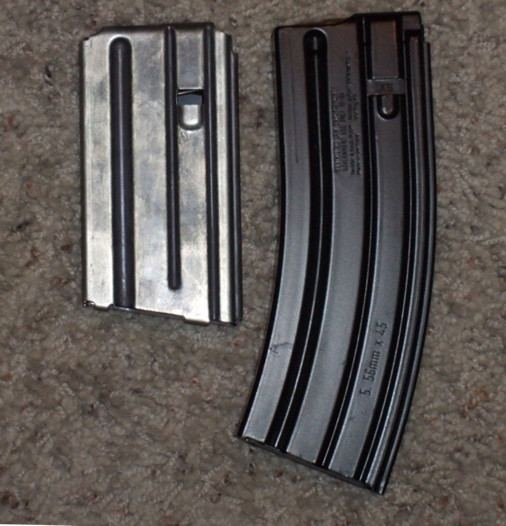 | ||
A STANAG magazine or NATO magazine is a type of detachable firearm magazine proposed by NATO in October 1980. Shortly after NATO's acceptance of the 5.56×45mm NATO rifle cartridge, Draft Standardization Agreement (STANAG) 4179 was proposed in order to allow NATO members to easily share rifle ammunition and magazines down to the individual soldier level. The U.S. M16 rifle magazine was proposed for standardization. Many NATO members, but not all, subsequently developed or purchased rifles with the ability to accept this type of magazine. However the standard was never ratified, in part due to German and French work on proprietary magazines respectively for the Heckler & Koch G11 and FAMAS, and remains a "Draft STANAG".
Contents
Magazines
The STANAG magazine concept is only an interface, dimensional and controls (magazine latch, bolt stop, etc.) requirement. Therefore, it not only allows one type of magazine to interface with various weapon systems, but also allows STANAG magazines to be made in various configurations and capacities. The standard capacities of STANAG-compatible magazines are 20 or 30 rounds of 5.56×45mm NATO ammunition. There are also 5-, 10-, 40- and 50-round box magazines, as well as 60- and 100-round casket magazines, 90-round snail-drum magazines, and 100-round drum magazines. There has also been a 150-round drum magazine produced.
Issues and improvements
The STANAG magazine, while relatively compact compared to other types of 5.56×45mm NATO box magazines, has often been criticized for a perceived lack of durability and a tendency to malfunction unless treated with a level of care that often cannot be afforded under combat conditions. Because STANAG 4179 is only a dimensional standard, production quality from manufacturer to manufacturer is not uniform. Magazines have been manufactured with lightweight aluminum or plastic bodies and other inexpensive materials in order to keep costs down, or to meet requirements that treat the magazine more as a disposable piece of equipment than one that is supposed to stand up to repeated combat use.
As a result, in March 2009, the U.S. military began to accept delivery of improved STANAG magazines. To increase reliability, these magazines incorporate heavier, more corrosion resistant springs and new tan-colored anti-tilt followers. In addition, many commercial magazine manufacturers now offer improved STANAG-compatible magazines. These magazines are made from high-grade stainless steel bodies, rust- and set-resistant chrome-silicon springs, and anti-tilt followers. There are also highly reliable polymer magazines, some with view windows, others are translucent.
ARDEC began development of a new magazine design in July 2013 to address feeding issues of older designs with the new M855A1 Enhanced Performance Round. It was first made public in 2014 and completed development in mid-2016 as the Enhanced Performance Magazine. The magazine uses a blue follower and a tan body which presents the rounds with a better angle to the weapon's feedway, preventing the hardened steel tip of the EPR from contacting the aluminum feed ramp of the M4 carbine, increasing mean rounds between stoppage by 300%.
STANAG magazine convertible rifles
Magnolia States Armory offers an adapter that allows the use of STANAG magazines in 5.56mm Galil rifles as well as one that works in a variety of 5.56mm AK-47 type rifles such as the Saiga, WASR3 and Norinco rifles.
Additional information
The "RAM-LINE 30-round COMBO MAG" is a uniquely notable STANAG magazine. These commercial translucent plastic magazines can be used in both AR-15 type rifles and Ruger Mini-14 type rifles.
